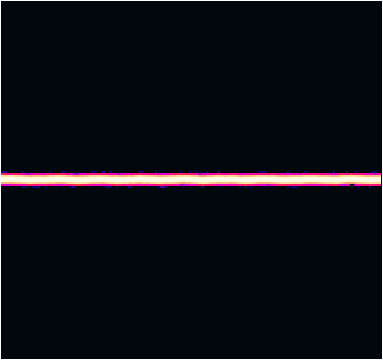Test Case 1 - 1D azimuthal PIC simulation of the EXB EDI
This test case is aimed at studying the possible development of microinstabilites induced by the large EXB electron drift in the magnetic barrier of a Hall thruster. The Electron Cyclotron Drift Instability (which we call EXB Drift Instability, EXB EDI, in the present context) studied in the 1970's in space plasmas, has been evidenced in axial-azimuthal PIC simulations of Hall thrusters.
The objective of the benchmark is to study the EXB EDI under 1D conditions (constant E and B, and description of the EXB direction) and the conditions of the possible transition to an ion acoustic instability. The effects of 1) numerical noise and accuracy of the simulations, 2), of the imposed spatial period in the azimuthal direction, and 3) of the re-injection of particles (i.e. finite length of the acceleration region) must also be evaluated
Conditions of the benchmark
-
1D-3V model periodic in the azimuthal direction y (EXB direction); length of periodic simulation domain in y direction: Ly
-
given electric field Ex in the direction x (axial direction) perpendicular to y , typically Ex=200 V/cm
-
given magnetic field Bz in the direction z perpendicular to x and y, typically Bz=200 Gauss
-
no collisions
-
1D PIC model coupling electron and ion transport + Poisson in the y direction
-
electrons and ions are subject to the self-consistent Ey field in the y direction and to the imposed constant Ex and Bz electric and magnetic fields.
-
initial conditions with equal and uniform electron and ion densities, on the order of np=10^(17) /m3, Maxwellian initial velocity distributions with temperature respectively on the order of a few eV and fraction of one eV
-
the conditions of Ref. 1 are used for the benchmark
What do we need to study ?
-
continuous acceleration : electrons and ions are not removed from the simulation domain and gain energy continuously along the x direction - use the conditions of Ref 1.
-
finite acceleration length : a more realistic situation corresponding to quasistationary conditions can be simulated by trying to "mimic" the finite lengthLch of the thruster channel. This can be done by removing electrons that travel a length l>Lch in the axial direction opposite to the given electric field Ex. This supposes that the position of the electron along the axial direction is recorded. When the electron is removed it is replaced by another electron from a Maxwellian distribution at temperature Te0. (eg 10 eV). The new electron can be placed randomly within the azimuthal simulation length or at the same azimuthal location . The same is done for ions but here it is simpler and better to use a simple removal frequency equal to the inverse of the ion transit time tr=(2Lch/a) (2Lch/a)1/2 in the channel, where a=eEz/m is the ion acceleration in the given external axial field or to use a constant ion beam velocity Vb_ion and remove the ions after they have drifted a length Lch in the z direction. . The removed ion is replaced by a new ion randomly distributed in the azimuthal direction, or at the same azimuthal position and with a Maxwellian velocity distribution at a temperature Ti0 (eg 0.2 eV). It turns out, as pointed out by F Taccogna, that the two methods of replacing particles (random azimuthal position or same azimuthal position lead to different results. In this benchmark the conditions can be the same as in Ref. 1 except that electrons and ions are removed as described above and replaced by a new electron or ion with a given velocity distribution function. The two methods of replacing particles must be checked.
-
the questions are: 1) do all the simulations (i.e. performed by different groups) in the conditions of Ref. 1 (continuous acceleration) give the same results and the same conclusions, 2) what is the effect of taking into account the (more realistic) conditions of finite acceleration length concerning the nature of the instability, the amplitude of the fluctuations, and the measured anomalous transport. The parameters of these simulations are Ex, Bz, and Lch. The periodic azimuthal length is also a parameter. Does the effective mobility tends to a constant value when the periodic azimuthal length of the simulation domain is increased.
-
Benchmark parameters for the reference case are:
- Ex=200 V/cm, Bz=200 Gauss, Lch=1 cm, Ly=1 to 5 cm
- np=10^(17) /m3, Te0=10 eV, Ti0=0.2 eV, Vb_ion=17 km/s
References
-
Reference for the benchmark
-
Other relevant references
-
T. Lafleur et al., Phys. Plasmas 23, 053502 (2016).
-
A. Ducrocq, J. C. Adam, A. Heron, and G. Laval, Phys. Plasmas 13, 102111 (2006)
-
J.-P. Boeuf, Front. Phys. 2, 74 (2014)
-


